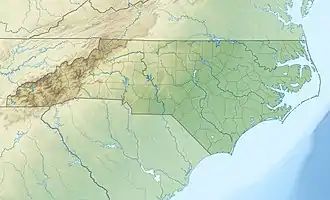Cow Branch Formation
The Cow Branch Formation is a Late Triassic (Carnian to Norian, or Tuvalian in the regional stratigraphy) geologic formation in the eastern United States.[1] Indeterminate fossil ornithischian tracks have been reported from the formation.[2]
| Cow Branch Formation Stratigraphic range: Carnian-Norian (Tuvalian) ~235–210 Ma | |
|---|---|
| Type | Geological formation |
| Unit of | Dan River Group |
| Location | |
| Coordinates | 36.4°N 80.0°W |
| Approximate paleocoordinates | 5.5°N 20.4°W |
| Region | Virginia |
| Country | |
 Cow Branch Formation (the United States)  Cow Branch Formation (North Carolina) | |
Fossil content
The following fossils have been reported from the formation:[1]
- Reptiles
- Mecistotrachelos apeoros
- Tanytrachelos ahynis
- cf. Pariostegus sp.
- Anthophyta indet.
- Fish
- Diplurus cf. newarki
- Cionichthys sp.
- Semionotus sp.
- Synorichthys sp.
- Turseodus sp.
- Ichnofossils
- Arachnids
- Argyrarachne solitus[3]
- Insects
- Alinka cara
- Architipula youngi
- Brachyrhyphus distortus
- Cascadelcana virginiana[4]
- Crosaphis virginiensis
- Holcoptera solitensis[5]
- Leehermania prorova
- Metarchilimonia krzeminskorum
- M. solita
- Mormolucoides articulatus[6]
- Phyloblatta grimaldii
- Prosechamyia dimedia
- P. trimedia
- Pseudopolycentropodes virginicus
- Triassonepa solensis[7]
- Triassopsychoda olseni
- Triassothrips virginicus
- Veriplecia rugosa
- Virginiptera certa
- V. lativentra
- V. similis
- Yalea argentata
- Y. rectimedia
- Archescytinidae indet.
- Blattodea indet.
- Diptera indet.
- Naucoridae indet.
- Orthoptera indet.
- Phoroschizidae indet.
- Thysanoptera indet.
- Tipulomorpha indet.
- Flora
- Lonchopteris virginiensis
- Pagiophyllum diffusum
- P. simpsoniae
- Zamites powellii
- cf. Acrostichites linnaeafolius
- cf. Compsostrobus neotericus
- Glyptolepis cf. platysperma
- Neocalamites cf. knowltonii
- cf. Zamiostrobus lissocardus
- Dictyophyllum sp.
- Glandulozamites sp.
- Lepacyclotes sp.
- Lepidodendron sp.
- Pagiophyllum sp.
- Pelourdea sp.
- Podozamites sp.
- Pterophyllum sp.
- Sphenozamites sp.
- Wingatea sp.
- cf. Dechellyia sp.
- cf. Elatocladus sp.
- cf. Grammaephloios sp.
- cf. Sagenopteris sp.
See also
- List of dinosaur-bearing rock formations
References
- Cow Branch Formation at Fossilworks.org
- Weishampel et al., 2004, pp.517-607
- Selden et al., 1999
- Fang et al., 2018
- Kelly et al., 2017
- Huber et al., 2003
- Criscione & Grimaldi, 2017
Bibliography
- Fang, Y.; A. D. Muscente; S. W. Heads; B. Wang, and S. H. Xiao. 2018. The earliest Elcanidae (Insecta, Orthoptera) from the Upper Triassic of North America. Journal of Paleontology 92. 1028–1034.
- Criscione, J., and D. Grimaldi. 2017. The oldest predaceous water bugs (Insecta, Heteroptera, Belostomatidae), with implications for paleolimnology of the Triassic Cow Branch Formation. Journal of Paleontology 91. 1166–1177.
- Kelly, R. S.; A. J. Ross, and P. Davidson. 2017. Mesozoic Holcoptera (Coleoptera: Coptoclavidae) from England and the United States. Proceedings of the Geologists' Association 128. 659–674.
- Blagoderov, V. A.; D. A. Grimaldi, and N. C. Fraser. 2007. How time flies for flies: diverse Diptera from the Triassic of Virginia and early radiation of the order. American Museum Novitates 3572. 1–39.
- Weishampel, David B.; Peter Dodson, and Halszka Osmólska (eds.). 2004. The Dinosauria, 2nd edition, 1–880. Berkeley: University of California Press. Accessed 2019-02-21. ISBN 0-520-24209-2
- Huber, P.. 2003. Early Jurassic insects from the Newark Supergroup, northeastern United States. In P. M. LeTourneau, P. E. Olsen (eds.). The Great Rift Valleys of Pangea in Eastern North America 2: Sedimentology, Stratigraphy, and Paleontology. 206–223.
- Selden, P. A.; J. M. Anderson; H. M. Anderson, and N. C. Fraser. 1999. Fossil araneomorph spiders from the Triassic of South Africa and Virginia. The Journal of Arachnology 27. 401–414.
- Olsen, P. E. 1979. A new aquatic eosuchian from the Newark Supergroup (Late Triassic–Early Jurassic) of North Carolina and Virginia. Postilla 176. 1–14.
- Olsen, P. E.; C. L. Remington; B. Cornet, and K. S. Thomson. 1978. Cyclic change in Late Triassic lacustrine communities. Science 201. 729–733.
This article is issued from Wikipedia. The text is licensed under Creative Commons - Attribution - Sharealike. Additional terms may apply for the media files.